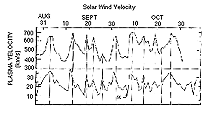|
The polar regions of the Sun also have such outwards-directed field lines, as evidenced by the "polar plumes" seen in the corona during a total eclipse of the Sun. It was therefore expected that the solar wind above the Sun's poles would be relatively fast and smooth-flowing. A mission to that region had been planned since the 1970s, and it led after many delays and cutbacks to the spacecraft Ulysses (Latin name of Odysseus), a joint European-NASA venture. Ulysses passed above the Sun's south pole in September 1994, and above the north pole in 1995.
All planetary orbits lie approximately in the same flat plane as that of the Earth ("plane of the ecliptic"), which is also close to the Sun's equatorial plane. To reach a position above the Sun's pole, Ulysses needed to be flung out of this plane, and it did so by first flying out to the planet Jupiter and then using that planet's gravity as a pivot while swinging into the third dimension. Ulysses has confirmed the existence of a steady fast-flowing solar wind above the poles and has observed many interesting phenomena associated with it.
The Ulysses mission has its own home page on the web, leading to many related files. To reach it, click here.
|

 Official GSFC Home Page
Official GSFC Home Page  NASA WWW Home Page
NASA WWW Home Page